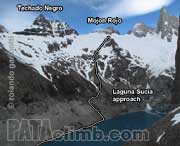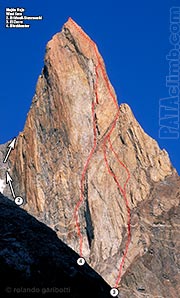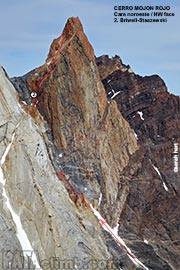Update: last updated on 24/02/2018.
Mojón Rojo (ca. 2170m).
The summit of Mojon Rojo provides excellent views of both the Cerro Torre and Fitz Roy massifs. The east face is a moderate, yet interesting route. It is surprising that this peak does not draw more people, since along with Cerro Solo, Gorra Blanca and Cerro Electrico is one of the best alternatives for fun “classic” mountaineering in the area.
|
Photos (click to enlarge)

Mojon Rojo - overview.

Mojon Rojo - Laguna Sucia
approach. 
Mojon Rojo - from the west.

Mojon Rojo - from the NW. |
1. Cara Este
150m 4 30˚
Cesarino Fava and José Mordini (AR), 1961.
Description. The climb involves several moderate pitches on firm rock (2 to 4) and an exposed traverse across the west side to reach the summit.
History. This was the first ascent of the peak. The original intention of their expedition was to recover Toni Egger’s body, but large amounts of snow and adverse conditions proved their efforts fruitless. However, they did manage to place a plaque in his memory at the base of Cerro Torre, not far from where supposedly he lost his life (likely he died descending from Col Standhardt, not on Cerro Torre as Cesare Maestri claims). The plaque was sent by the SAT from Trento. This expedition was only possible thanks to the help given by Tito Lucchini and Carlo Turrini.
Approach. Laguna Sucia to Glaciar Río Blanco Superior.
Pro. Glacier travel kit, plus a few stoppers and cams.
Descent. Via the same route.
Bibliography. AAJ 1962 p. 263, CAI-Rivista mensile M 80/5-6 p. 179-180; Alpinisti Italiani nell Mondo, Commissione Centrale delle Pubblicazioni, Club Alpino Italiano 1972/2 p. 838-839; Bolletino SAT 1961/1-2 p. 15; Bolletino SAT 1961/4 p. 13. |
2. Cara Noroeste
300m 60˚ 5+
Jim Bridwell (US) and Robert Staszewski (AU), in late March 1978.
Description. Approach via the Torre valley and climb the couloir just north of the peak (500m 40˚) to where it gets steeper. The following five pitches constitute the crux of the route. Two pitches of ice to 60˚ lead to a slabby ramp and after a loose corner climb easy slabs to one last pitch (5+).
History. The couloir leading to the col was first climbed by Ted Coates and Hugh Logan (NZ) in 2/1976. They used it to approach the Cara Este route on Aguja de l'S. Bridwell and Staszewski completed their line in two days. They were supported by Bob Killipand and John Nitschke. Scott Cole (US) repeated this line or climbed a paralel line in November 1987.
Approach. Before Niponino.
Descent. To the east, to Laguna Sucia?
Bibliography. AAJ 1978 p. 584; Mountain Magazine 55 p. 11. |
3. El Zorro
700m 6b+
Colin Haley (US) and Sarah Hart (CA), 2/2013
Description. Approach via the Torre valley and climb the couloir just north of the peak to then head right onto the west face of the peak. The first half of the route climbs a subtle buttress and is mostly simul-climbing with one section of 6a+. At the top of the buttress follow an easy gully feature, which leads to the crest of the west ridge, at a notch with a tower. The route from here climbs spectacular crack systems on the face just left of the west ridge, with features always connecting just enough for enjoyable 6a/b climbing. As it nears the top of the face continue connecting face cracks right of an obvious chimney. The climbing remains in the 6a/b range until the last few meters of the face, 6b+ (two fixed pitons). Upon gaining the top of the pillar one traverses a knife-edge ridge, making one short rappel, to reach the base of the summit tower. Two more rope-lengths lead to the scrambling terrain on the east face, and an exposed V0 boulder problem to the true summit.
History. The name refers to the red color rock (after red foxes) and also refers to the fox that spent much of the 2012-13 season hanging out at Niponino. The first ascent was done in one day from Niponino, climbing up and over desceding to the east, via Laguna Sucia.
Approach. Before Niponino.
Pro. Bring some KBs.
Descent. To the east, to Laguna Sucia.
Bibliography. Haley's blog.
|
4. Blockbuster
500m 6c
Luka Krajnc and Tadej Krišelj (SI), 1/2015
Description. Climbs 15 new pitches joining El Zorro four pitches below the summit of the pillar (630m in all). From the top of the pillar the first ascensionists traversed off to reach easy ground and descend, not climbing the final wall to the main summit. The quality of the rock isn't great. Many loose blocks. The rock improves in quality significantly upon joining El Zorro.
History. The name refers to the quality of the rock.
Approach. Before Niponino, up scary loose moraine and an ugly gully.
Pro. 2ea to #3, 1 #4, a couple of pitons.
Descent. To the east, to Laguna Sucia.
|
Please Do Not Reprint This Article.
This article is copyrighted. Please do not reprint this article in whole or part, in any form, without obtaining written permission.
Feedback.
if you find any mistakes or if you have additional information, please go to the contact page and let us know.
|
Mojón RojoEast face 1. Cara EsteWest face2. Cara Noroeste3. El Zorro4. Blockbuster |



